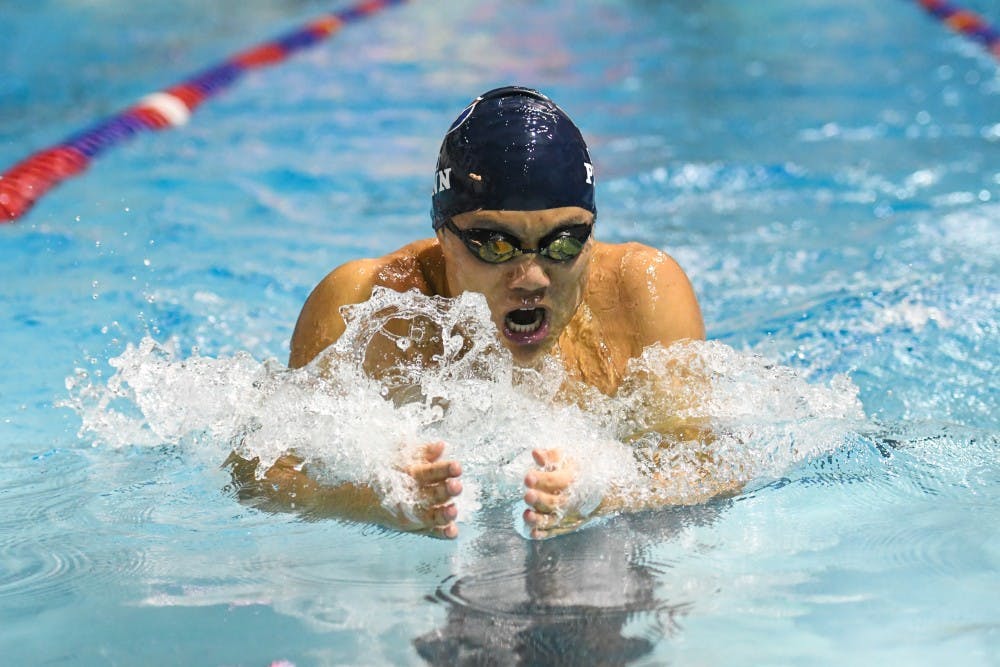
Sophomore Boris Yang is one of the Penn swimmers who has used cupping therapy to improve performance in the pool.
Credit: Son NguyenDuring the 2016 Olympics in Rio de Janeiro, American swimming legend Michael Phelps came under the spotlight not only for his five-gold medal tally but also for the marks on his back.
Phelps was carrying the expectations of an entire country, but what proved newsworthy were his large purple “bruises.”
It turns out Phelps and other American swimmers have turned to cupping, a type of therapy believed to have originated from Ancient Egyptian and Chinese cultures. Cupping, or “ba guan” in Chinese, literally refers to the act of “pulling out jars” — which is exactly what the treatment involves.
Special “cups” are heated and placed on the skin for a short amount of time, creating a vacuum in those areas. Penn uses a rubber pump to form the vacuum inside the cup, while other types of cupping involve a flammable substance. With the force of suctioning, the skin rises with the expansion of local blood vessels, causing blood to circulate more rapidly to the cupped areas.
For Penn swimming, cupping is perhaps not as prevalent as it was immediately after the 2016 Olympics, according to coach Mike Schnur.
“Swimmers from our class of 2016 and 2017 did a lot of cupping," Schnur said. "But in our current team, I don’t remember too many people who are right now. Even if they are, I never saw any changes in their performance.”
Sophomore Boris Yang, who hails from Hong Kong, has regularly visited practitioners to receive cupping treatment.
“I did [cupping] regularly [in Hong Kong], perhaps once every few weeks, mostly on my lats," Yang said. "I used the traditional fire cups, which hurt a bit when they are first put on my skin but feel quite good once they are taken off.
“I haven’t been [cupping] as frequently since coming to Philadelphia because we don’t often have these resources. There is a masseur who comes to Penn during every big swim meet, and he does cupping.”
By increasing blood flow, cupping is thought to help reduce muscle tension and promote cell repair – functions that serve swimmers well with their high level of physical exertion. Yang certainly believes he has been reaping the rewards of cupping therapy in the pool.
“It was a Chinese medicine practitioner who introduced me to cupping, saying it would help me with my swimming," he said. "I think [cupping] actually does relax my muscles.”
However, fellow sophomore swimmer Keanan Dols, who was recently named Male Athlete of the Year by the Aquatic Sports Association of Jamaica, is more skeptical about the treatment.
“I’ve done [cupping] a handful of times before, but I didn’t really feel any different," Dols said. "I’d say massages are more helpful."
As is the case with acupuncture and chiropractic procedures, there is a lack of scientific literature supporting the efficacy of cupping. Schnur acknowledges that with these forms of alternative treatments, there is a possibility that the placebo effect might play a part.
“Some seem to tell me [cupping] helped, some tell me it didn’t," Schnur said. "I think it could be mostly up here [mentally]. Swimmers are very mental creatures.”
Whether cupping helps or not, it has certainly made a big impact in the swimming world.
The Daily Pennsylvanian is an independent, student-run newspaper. Please consider making a donation to support the coverage that shapes the University. Your generosity ensures a future of strong journalism at Penn.
Donate







